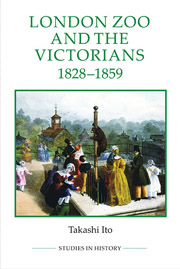Book contents
- Frontmatter
- Contents
- List of figures
- List of tables
- Acknowledgements
- Abbreviations
- Dedication
- Introduction: the zoo in history
- 1 The site of animal spectacle
- 2 Collecting and displaying
- 3 The question of access
- 4 Between science and commerce
- 5 Illusionary empire
- Conclusion: the Darwinian moment
- Appendix
- Bibliography
- Index
Appendix
Published online by Cambridge University Press: 05 April 2014
- Frontmatter
- Contents
- List of figures
- List of tables
- Acknowledgements
- Abbreviations
- Dedication
- Introduction: the zoo in history
- 1 The site of animal spectacle
- 2 Collecting and displaying
- 3 The question of access
- 4 Between science and commerce
- 5 Illusionary empire
- Conclusion: the Darwinian moment
- Appendix
- Bibliography
- Index
Summary
Financial details of the Zoological Society of London are contained in the Reports of the council and auditors, published annually from 1829. The fiscal year began on 1 January, and the Report for the previous year was printed by the council in the following late April or early May, to be presented at the annual meeting of the society. The Report also showed attendance figures at the London Zoo over the previous year. The original source for attendance figures was the daily record kept at the zoo gate. Monthly attendance is calculated from this record. The exact annual attendance figures from 1828 to 1900 are also summarised in Scherren, The Zoological Society, and Åkerberg, Knowledge and pleasures.
It should be noted, however, that attendance figures do not indicate how many individuals visited the zoo, because some were likely to attend more than once a year. There might also be a considerable number of ‘illegitimate’ visitors whose entries were not registered in the daily record, especially during the period between 1828 and 1847/8, when the society maintained its exclusive admissions policy. Nevertheless, the statistics can be read, with some reservation, as a barometer of the zoo's popularity. In comparison with the British Museum and the National Gallery, the London Zoo was the most popular institution during the first few years after its opening, but gradually declined in the late 1830s and the 1840s. Clearly, the trend in attendance affected the financial situation of the Zoological Society.
- Type
- Chapter
- Information
- London Zoo and the Victorians, 1828-1859 , pp. 173 - 178Publisher: Boydell & BrewerPrint publication year: 2014

